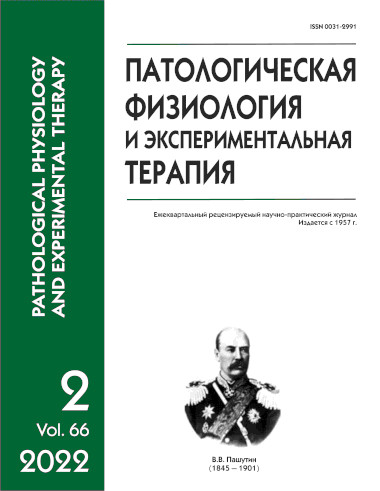Comparative morphometric characteristics of edema-swelling manifestations in the amygdala of adult white rats after 20-, 30-, and 40-min common carotid artery occlusion
Abstract
Aim. To study structural changes and to present a morphometric description of edema-swelling manifestations in the amygdala of rats after 20-, 30-, and 40-min common carotid artery occlusion (CCAO). Methods. Acute ischemia was modeled in white adult Wistar rats by 20- (group I), 30- (group II) and 40-minute (group III) CCAO. Histological (hematoxylin-eosin staining, Nissl staining), immunohistochemical (MAP-2, GFAP) and morphometric methods were used. A morphometric analysis was performed on preparations stained with hematoxylin-eosin using ImageJ 1.53 plug-ins (Find Maxima, Find Foci). Statistical hypotheses were tested (nonparametric tests) with the Statistica 8.0 software. Results. After 20-, 30,- and 40-min CCAO, signs of cytotoxic edema-swelling appeared, and focal destructive and adaptive changes in neurons and astroglia were observed in the amygdala. The manifestations of edema-swelling persisted to varying degrees throughout 7 days of observation. The relative area, the number of edema-swelling zones, and the degree of their hydration (pixel brightness) were significantly increased. One and 3 days after CCAO, a part of astrocyte processes in the amygdala was destroyed. After a unilateral 30-min and bilateral 20-min CCAO, mild and moderate, and after a bilateral 40-min CCAO, moderate and pronounced small-focal structural and functional changes developed. These changes were associated with emergence of enlightened zones in the “porous” neuropil and of pronounced perivascular and perineuronal edema of astrocyte processes. Perineuronal edema was associated with a moderate reduction of the overall numerical density of neurons (ONDN). Compared to the control, ONDN in group I decreased by 10.2% (p=0.03), in group II, by 11.4% (p=0.03), and in group III, by 12.9% (Mann –Whitney U-test, p=0.01). Conclusion. In the amygdala after CCAO, signs of edema-swelling appear on the background of dystrophic and necrobiotic changes in neurons and of the activation of neuroglial cells. These signs were most pronounced 3 days after bilateral 40-min occlusion. With unilateral occlusion, these changes were observed also in the hemisphere on the ipsilateral side.






